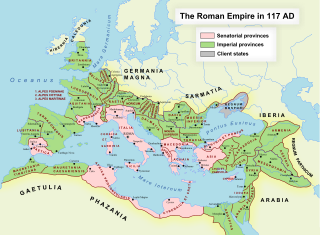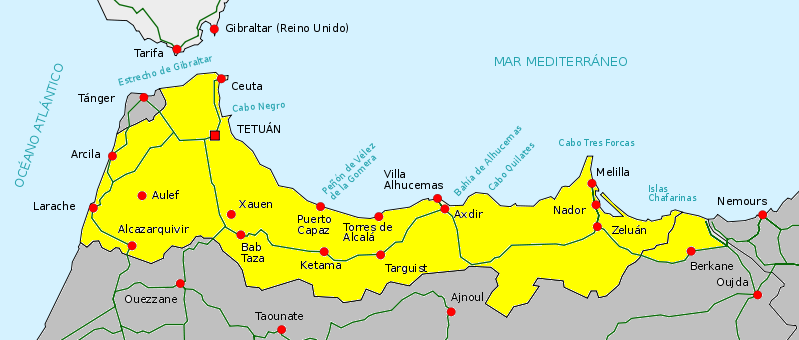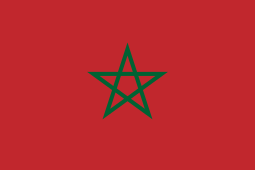
The study of Morocco has
led me to the following thesis. Morocco’s unique geographical
location in Africa combined with its long and rich
history make it a must visit country on any
world traveler list.
Morocco
is in the northwest corner of Africa. It borders Algeria and the disputed area
of
Western Sahara. It has an extensive coastline that is
over 1,700 kilometers and includes the
Atlantic Ocean and Mediterranean Sea. The Atlantic
Ocean and Mediterranean Sea is connected
by the Strait of Gibraltar. The Strait of Gibraltar
also separates Morocco from Spain. The
separation is small. The Strait of Gibraltar is 36
miles long and ranges from 8 to 27 miles
(Map of Morocco. Credit: http://www.operationworld.org/country/moro/owtext.html)
Physical evidence shows
that Morocco was first inhabited by the Berbers around 3,000
to 2,000 BC.[3] These ancient people left
behind cave paintings and rock art which can
Morocco today are Berbers but there are many people who
identify as Arab Berber, a mixture of
Arab and Berber.[6]
(Morocco rock art. credit: https://africanrockart.org/rock-art-gallery/morocco/)
Around
the 12th century BC the first invaders came to Morocco. The invaders
were
Phoenicians who
originated from modern day
Lebanon.[7] Phoenicians brought the
alphabet and
expert trading skills.[8]
The
next major foreign dominance of Morocco was from Carthage. The city of Carthage
started to really expand and gain wealth after
Phoenicians settled there who fled the city of Tyre
as it was being destroyed by Alexander the Great in
332 BC.[9] Carthage became
independent of
the Phoenicians and ruled a vast empire that included
North Africa, southern Spain,
Mediterranean Islands like Sardinia and Corsica and
parts of Sicily.[10]
(Carthaginian Empire map. credit: https://turmoilinmena.wordpress.com/2015/09/11/introduction-to-tunisia-and-some-tunisian-current-events/)
Morocco
came under Roman control after Rome’s victory over Carthage in the Punic
Wars.[11] Evidence of the Roman
period can be seen in the ruins of the ancient city Volubilis
which still stands today. This is a United Nations
world heritage site and is very popular with
international tourists.[12]
(Volubilis, Morocco credit: http://alcfezbook.com/volubilis-and-meknes-trip-for-alc-and-alif-students-2/)
The
culture and religion of modern day Morocco starts with the Arab invasion and
Islamic conquests of the 7th century AD.[13] Berbers were able to
regain political control from the
Arabs in 740 AD.[14] The Berbers converted to
Islam before they regained control. Once they
regained control of Morocco they kept Islam as the
majority religion.
The
spread of Islam inspired the Arabs and Berbers to invade Spain in the 8th
century.
There is some speculation that the people of Spain initially
welcomed the invasion because they
were very unhappy with the ruling Visigoths as the
Roman Empire crumbled.[15] Over time the
Christians in Spain slowly took back territory. The
Spaniards called the mix of Berbers and
Arabs, Moors. The last Moors in Spain were defeated in
Granada in 1492.[16]
(Alhambra Palace in Granada, Spain. Architecture of the Moors. credit:http://wordsabouttravel.com/travel/spain/granada/visiting-the-alhambra-palace-in-granada-spain/)
Many places in Africa had
no contact with Europe until Colonialization. Morocco’s
unique geographical location meant that it had
constant contact with Europe and Asia for
thousands of years. You can architecture in Spain and
Morocco that reflects these interactions
over thousands of years.
After
1492 Spain held territories in Morocco. Today Spain still controls two cities
in
Morocco along the Mediterranean coastline. These
cities are Ceuta and Melilla.[17] You could visit
Morocco and go to one of these two cities and
technically be in Spain.
From
1912 to 1956 Morocco was a Protectorate of France. France and Spain signed an
agreement that allowed Spain to continue to control
the territories they had established from
the 15th century.[18] Some of this territory
included the Western Sahara which is a source of
controversy today.[19]

(Western Sahara credit: http://westernsahararesourcecenter.blogspot.com/2011/01/where-is-western-sahara.html)
In
1956 Morocco became an independent nation. Its government is a constitutional
monarchy with a parliament. The present King is
Mohammed VI. King Mohammed VI is a
direct descendant of the Prophet Mohammed therefore
his title also includes “Commander of
the Faithful”.[20]

Perhaps from reading the history of Morocco you might think
that it would be a country
that is intolerant of
religions other than Islam. Morocco has a long history of tolerance towards
Judaism. Jews have been
living in Morocco for thousands of years. Some people speculate Jews
first arrived in Morocco
during the reign of King Solomon. Before Islam some of the Berber
tribes even converted to
Judaism.[21] Jews were welcomed in
Morocco who were fleeing Spain
during the Spanish
Inquisition. During World War II, King Mohammed V of Morocco
refused to comply with
the French Vichy Government and turn over Jews to Nazi Germany.[22]
During World War II there
was over 250,000 people in the Jewish community in Morocco. Since
the nation of Israel was
established many Jews have left Morocco for Israel. Today it is
estimated that less than
5,000 Jews remain in Morocco. King Mohammed VI has instructed the
government to preserve
Jewish cultural and historical sites before there are not any Jews left in
Morocco.[23]
This is just a brief history of
Morocco over the past 5,000 years. Morocco is one of the
few places in the world
where you can witness history of the world’s most influential
monotheistic religions of
Christianity, Islam, and Judaism. It has a hospitable Mediterranean
climate along the coasts and
a rich culture which includes amazing food, diverse history, and
impressive geography. It
is certainly a country worth visiting.
[1]
Swearingen, Will D., Susan Gilson Miller, Nevill Barbour, Abdallah Laroui, and
L. Carl Brown. "Morocco." Encyclopædia Britannica. November 23, 2017.
Accessed December 01, 2017. https://www.britannica.com/place/Morocco.
[2]
"History of Morocco | Morocco Information." Marokko Informatie.
Accessed December 20, 2017. https://www.marokko-info.nl/history-of-morocco/.
[3]
The Political and Economic History of Morocco. Accessed December 20, 2017.
http://www.sjsu.edu/faculty/watkins/morocco.htm.
[4]
"Morocco - Trust For African Rock Art". Last modified 2017. Accessed
November 10, 2017. https://africanart.org/rock-art-gallery/morocco/.
[5]
Brett, Michael. "Berber." Encyclopædia Britannica. January 21, 2016.
Accessed December 20, 2017. https://www.britannica.com/topic/Berber.
[6]
IBID.
[9]
“Phoenicia." Geography. Accessed December 20, 2017. http://geography.name/phoenicia/.
[10]
Mark, Joshua J. "Carthage." Ancient History Encyclopedia. April 28,
2011. Accessed December 20, 2017. https://www.ancient.eu/carthage/.
[11] “Carthage"
Geography. Accessed December 20, 2017. http://geography.name/carthage/.
[12]
Centre, UNESCO World Heritage. "Archaeological Site of Volubilis."
UNESCO World Heritage Centre. Accessed December 18, 2017.
http://whc.unesco.org/en/list/836.
[13]
"History & Politics." Our Africa. Accessed December 20, 2017.
http://www.our-africa.org/morocco/history-politics.
[14]
IBID.
[15]
"List your Spain or Canary Isles Holiday Rental or B&B FREE of
CHARGE." History of Spain - The Moors. Accessed December 18, 2017. https://www.spanish-web.com/history/moors.php.
[16]"History & Politics." Our Africa. Accessed December 20, 2017.
http://www.our-africa.org/morocco/history-politics.
[17]
"History of Morocco - Discover an Ancient Land." Morocco.com -
Morocco Channel. Accessed December 11, 2017.
http://www.morocco.com/culture/ancient-morocco.
[18]
IBID.
[19]
"History & Politics." Our Africa. Accessed December 20, 2017.
http://www.our-africa.org/morocco/history-politics.
[20]
"History of Religion in Morocco." Islam in Morocco - History of
Religion | Travel Blog | About Us | Naturally Morocco. Accessed December 15,
2017. http://www.naturallymorocco.co.uk/about-us/morocco-travel-blog/islam-in-morocco-history-of-religion.html
[22] "History & Politics." Our
Africa. Accessed December 20, 2017.
http://www.our-africa.org/morocco/history-politics.
[23} IBID.










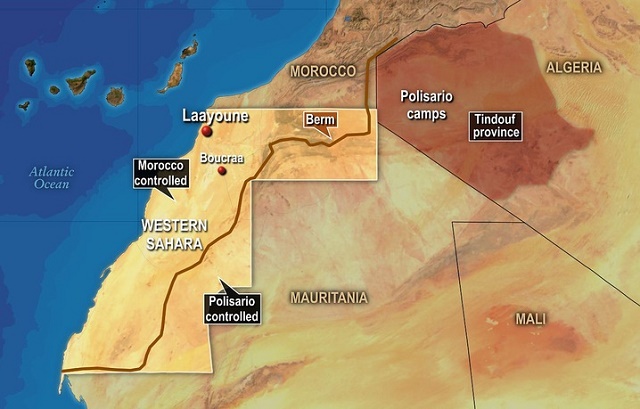
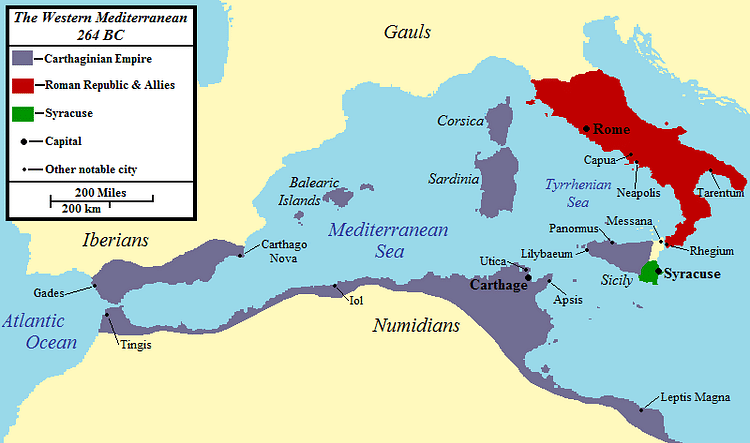

 Hassan II Mosque in Casablanca, Morocco
Hassan II Mosque in Casablanca, Morocco
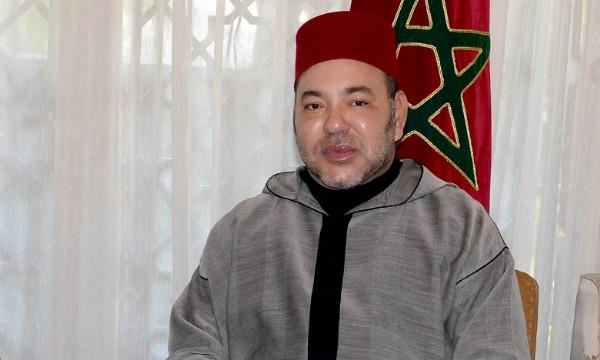
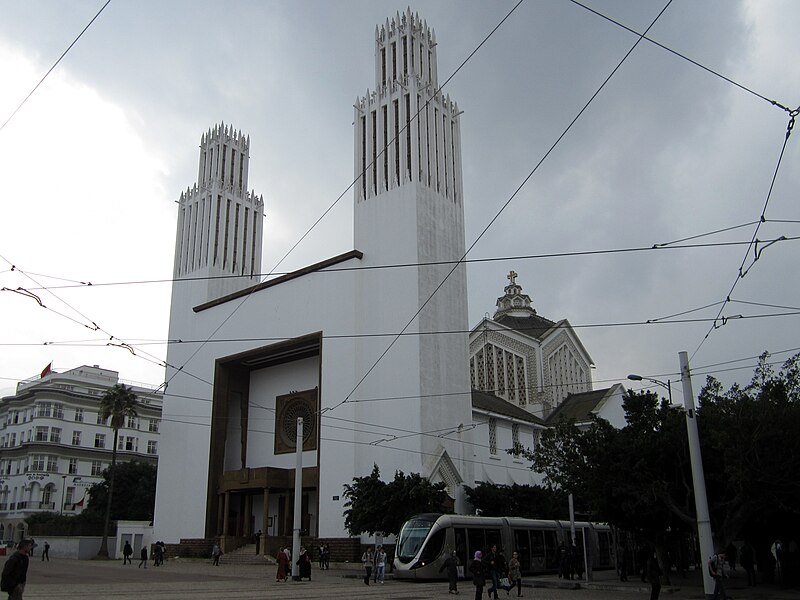 St. Peter's Cathedral - Rabat, Morocco
St. Peter's Cathedral - Rabat, Morocco

